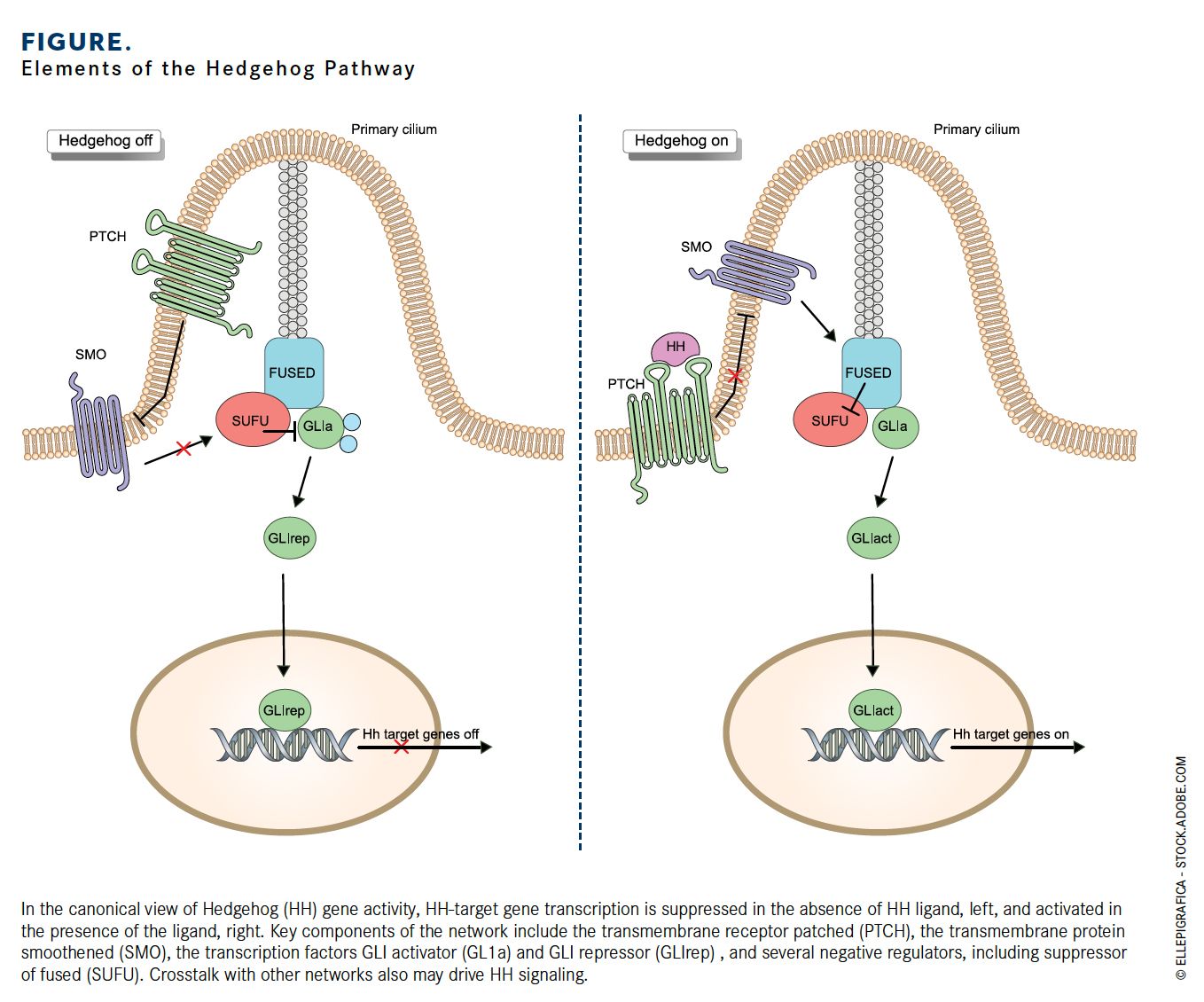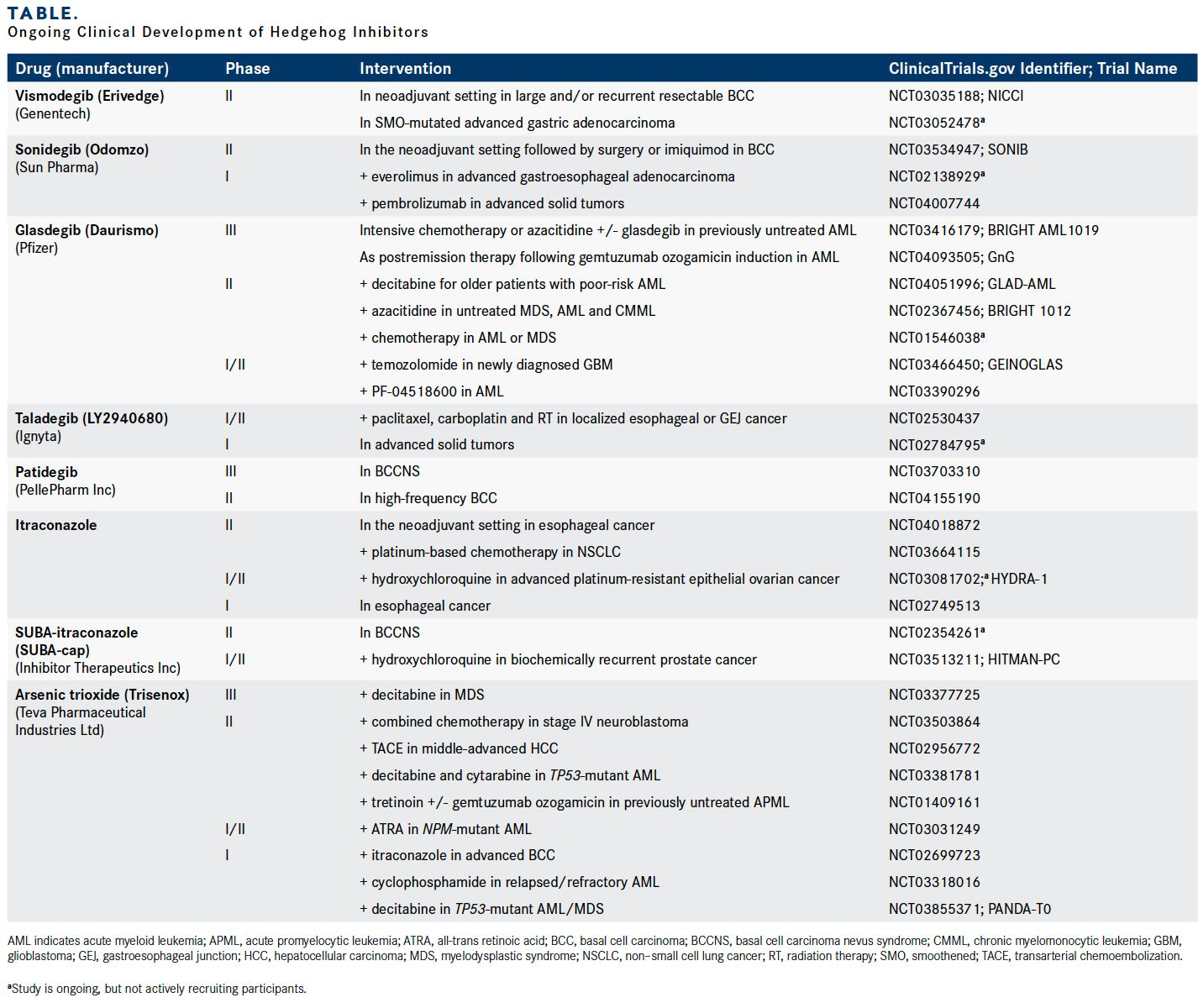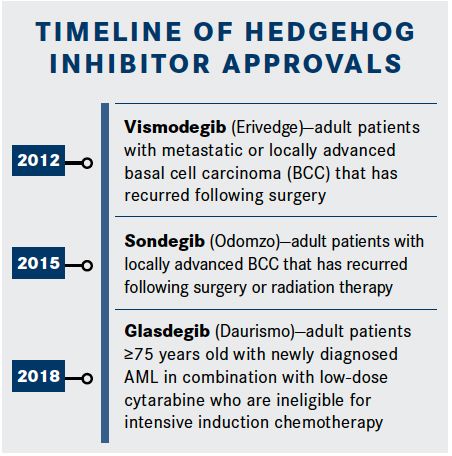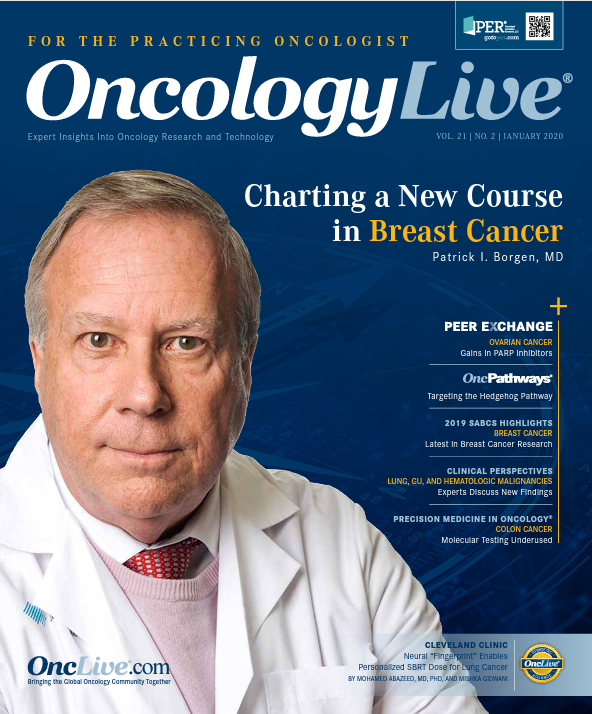Publication
Article
Oncology Live®
Targeting the Hedgehog Pathway Holds Promises and Pitfalls
Author(s):
Although small molecule inhibitors of the Hedgehog signaling pathway have transformed the treatment paradigm for advanced basal cell carcinoma, the most common form of skin cancer, efforts to expand their use to other tumor types have proved elusive.
Although small molecules inhibitors of the Hedgehog (Hh) signaling pathway have transformed the treatment paradigm for advanced basal cell carcinoma (BCC), the most common form of skin cancer, efforts to expand their use to other tumor types have proved elusive.
Unfortunately, the agents’ reputation has been tarnished by high discontinuation rates due to adverse events (AEs). These AEs are largely manageable and reversible, however, and recent data suggest that long-term efficacy can be achieved in patients who respond, even after discontinuing treatment.
Recently, Hh inhibitors (HHIs) showed success in the treatment of leukemia, culminating in the November 2018 approval of glasdegib (Daurismo) for patients with acute myeloid leukemia (AML) who are unable to tolerate chemotherapy. Furthermore, a first-in-class topical HHI, patidegib, currently in clinical development shows reduced systemic AEs.
Meanwhile, ongoing efforts seek to find alternative ways to target the Hh pathway and design rational drug combinations to overcome resistance, another major challenge that appears to occur broadly across the current drug class.
Today, clinical development of therapeutic strategies leveraging the Hh pathway consists of a small playing field of FDA-approved and novel agents that are being evaluated in a range of tumor types (Table).
From Fruit Flies to Cancer
The Hh transduction cascade is among the pathways intricately involved with the primary cilium, a small, hairlike structure found on the surface of most mammalian cell types. Its function long remained elusive; the primary cilium was thought to be a vestigial organelle, an evolutionary throwback. However, its defects began to be linked to a growing number of diseases, illuminating the primary cilium’s vital roles as a sensory organelle and key coordinator of cell signaling.1,2
Figure. Elements of the Hedgehog Pathway (Click to Enlarge)

The primary cilium plays a critical coordinating role in the Hh pathway. Discovered more than 35 years ago in genetic screens of fruit flies, the hh gene received its name because larvae lacking it appeared to be covered in hedgehoglike spiky denticles due to developmental patterning abnormalities.3
In mammals, 3 genes encode HH ligands: sonic (SHH), desert (DHH), and Indian hedgehog (IHH). Each encodes a protein that serves as an activating ligand in the Hh signaling pathway, with SHH the most widely expressed and thoroughly studied. The HH ligands bind predominantly to a transmembrane receptor called patched 1 (PTCH1). Other key components of the Hh pathway are the G protein—coupled receptorlike transmembrane protein smoothened (SMO), a family of transcription factors (GLI1, 2, and 3), and several negative regulators, including protein kinase A (PKA) and suppressor of fused (SUFU).4-8
In the absence of a ligand, PTCH1 is localized to the primary cilium, where it suppresses SMO activity through an undetermined mechanism; SUFU binds full-length GLI proteins, anchoring it in the cytoplasm and preventing it from activating target gene transcription; and PKA phosphorylates GLI, prompting its cleavage to a repressor form that inhibits Hh target gene expression in the nucleus.
When HH ligand binds to PTCH1, both are taken up into the cell, relieving the suppression of SMO, which then accumulates in the primary cilium.4-8 Signaling by SMO triggers activation of the fulllength GLI proteins and their dissociation from SUFU, allowing them to translocate to the nucleus, where they initiate transcription of Hh target genes. The genes for which transcription is stimulated by Hh signaling reflect its vital, evolutionarily conserved roles in embryonic development, tissue homeostasis, and stem cell maintenance.4-8
The simplified scenario above describes the canonical Hh signaling pathway; however, numerous other signaling cascades can feed into this pathway, triggering GLI activity independently of upstream Hh pathway components such as SMO in the broader spectrum of noncanonical Hh signaling (Figure).5,6
Avenues of Activation
Inappropriate activation of the Hh pathway can lead to cancer, an association first uncovered when Hh defects were linked to basal cell carcinoma nevus syndrome (BCCNS).
This rare genetic condition is characterized by a markedly increased incidence of BCC and elevated risk of medulloblastoma, owing to inherited defects in the PTCH1 gene. Mutations in Hh pathway genes subsequently have been identified in the vast majority of patients with sporadic BCC and in a significant proportion of those with medulloblastoma.4-8
In these cancer types, activation of the Hh pathway is ligand independent, involving activating mutations in SMO or inactivating mutations in PTCH1 or SUFU that cause the pathway to become active in the absence of HH ligand.4,7,8
Ligand-dependent activation of the Hh pathway has been widely described in tumor types other than BCC and medulloblastoma. However, mutations in Hh pathway genes have not been identified in these tumor types, leading to controversy regarding whether these reports reflect genuine Hh pathway activation.9,10
In ligand-dependent pathway activation, tumor cells overexpress HH ligand, which can act in an autocrine fashion, stimulating activation of the Hh pathway in the tumor cell itself, or in a paracrine fashion, acting on surrounding stromal cells and fostering a protumor microenvironment. A reverse paracrine mechanism has also been described in hematologic malignancies, in which HH ligand produced by stromal cells in the bone marrow activates Hh signaling in cancer cells.10,11
Finally, cross talk between the Hh pathway and many other potentially tumorigenic pathways, such as PI3K, AKT, mTOR, and MAPK, can drive aberrant activation of noncanonical Hh signaling.5,6,12
A Role for SMO Antagonists
Because the Hh pathway has emerged as a key player in BCC, investigators have attempted to target it therapeutically, with a focus on SMO as the predominant druggable protein in the network. The FDA approved the first-in-class SMO antagonist vismodegib (Erivedge) in 2012 after successful clinical testing in patients with locally advanced and metastatic BCC.13 The pivotal trial evaluated the safety and efficacy of vismodegib in 1215 patients and demonstrated response rates of 68.5% and 36.9% in patients with locally advanced and metastatic disease, respectively.14
This was followed by the 2015 approval of a second SMO antagonist, sonidegib (Odomzo), for patients with locally advanced, recurrent BCC based on the results of the phase II BOLT trial.15,16 Two different once-daily doses (800 mg or 200 mg) were given to 230 patients with metastatic or locally advanced BCC. Assessment by central review of patients in the primary efficacy analysis population revealed that, among those with locally advanced disease, the objective response rates were 38% and 43% in the 800-mg and 200-mg dose groups, respectively. In those with metastatic disease, objective responses were observed in 17% and 15%, respectively.16
A recent meta-analysis comparing vismodegib and sonidegib found that the 2 drugs conferred similar overall response rates in patients with locally advanced BCC, but patients with metastatic disease had a 2.7-fold higher overall response rate with vismodegib (39%) than with sonidegib (15%). Furthermore, patients with locally advanced disease exhibited a markedly higher complete response (CR) rate with vismodegib treatment (31% vs 3%).17
Figure. Fast Facts Hedgehog Pathway (Click to Enlarge)

Potential Drawbacks
Adverse Events
One of the pitfalls of HHI therapy is the high rate of discontinuation due to AEs. Patients receiving HHIs typically experience at least 1 treatment-related AE. Most commonly, these include hair loss, muscle spasms, fatigue, nausea, vomiting, and a distorted sense of taste.4
In the vismodegib trial, serious treatment- emergent AEs (TEAEs) occurred in 23.8% of patients, and there were 46 fatal TEAEs, 7 of which were judged to be related to vismodegib.13 In the BOLT trial, seriousAEs were reported in 14% of patients treated at the 200-mg dose and 30% of those who received the 800-mg dose. There were 4 deaths, none of which were related to sonidegib treatment.16
In a meta-analysis, the AE profiles of the 2 drugs were similar, except for upper gastrointestinal symptoms and myalgias, which were more frequently experienced with sonidegib. Overall, more than a quarter of patients stopped treatment due to intolerable AEs.17
Although the discontinuation level is high, most AEs are reversible and manageable with appropriate supportive care. Furthermore, a recently published observational retrospective study conducted in France revealed that patients who had achieved CR on vismodegib and subsequently discontinued treatment could experience long-term disease control.18
A total of 116 patients were followed for a median of 34.9 months after discontinuation of vismodegib. Median relapse-free survival (RFS) was 18.4 months. The RFS rate at 36 months was 35.4% for the overall population and 40% for patients without BCCNS. In addition, among 27 patients who relapsed during follow-up, re-treatment with vismodegib produced an objective response rate of 85%.18
Patidegib is being developed in the hopes of avoiding some of the systemic toxicity associated with traditional treatments. Promising results from 2 clinical trials were presented at the Rare Diseases and Orphan Products Breakthrough Summit held by the National Organization for Rare Disorders in 2018. After patidegib received both breakthrough therapy and orphan drug designations from the FDA, the pharmaceutical company PellePharm recently initiated a phase III trial in patients with BCCNS.19,20
Table. Ongoing Clinical Development of Hedgehog Inhibitors (Click to Enlarge)

Resistance Mechanisms
Developmennt of resistance presents another significant impediment to HHI efficacy. The results of one study showed that 21% of patients undergoing continuous vismodegib treatment developed resistance, with a median time to tumor regrowth, as detected by clinical examination, of 56.4 weeks.21 Some studies have suggested that there is cross-resistance among SMO antagonists, with resistance to 1 implying resistance to others.4
A reported mechanism of resistance to vismodegib is the acquisition of mutations in the SMO gene that block the drug’s ability to bind and inhibit SMO protein.22,23 Other mechanisms of HHI resistance include amplification of downstream effectors, particularly the GLI genes, mutations in genes controlling ciliogenesis,24 and alterations in noncanonical signaling pathways that activate GLI directly, bypassing SMO and other upstream components of the Hh pathway.5,10
Several tactics are being explored to help overcome resistance, including development of SMO antagonists that can bind to resistant forms of the protein. Taladegib produced responses in 46.8% of patients with BCC. Of 6 posttreatment tumor biopsies tested, 5 exhibited SMO mutations, including 2 with the common D473H mutation.25
Itraconazole, an FDA-approved antifungal drug, has emerged as a SMO inhibitor with a mechanism of action distinct from that of other SMO antagonists, such as vismodegib. It is also reported to be active against all known drug-resistant SMO mutants.8 Clinical trials are examining both itraconazole and SUBA-itraconazole (SUBA-Cap), a reformulation with improved bioavailability.
There is also interest in developing alternative strategies for targeting the Hh pathway, particularly by inhibiting the GLI proteins, and in designing rational combination strategies to overcome resistance, such as combinations of HHIs with PI3K/ mTOR inhibitors. Clinical development of GLI antagonists has been limited to date, apart from the approval of arsenic trioxide, a drug that binds to the GLI1/2 proteins and inhibits their transcriptional activation of Hh target genes, for the treatment of acute promyelocytic leukemia.5,12
Beyond Skin Cancer
It was initially hoped that HHIs might be beneficial in up to 25% of human cancers.9 Studies have suggested that the Hh pathway is activated across a broad range of tumor types, including pancreatic, colorectal, breast, lung, and prostate cancers, as well as a range of hematologic malignancies.4
Clinical trials in cancer types other than BCC, however, have proved disappointing. Vismodegib failed to produce a clinical benefit in patients with castration- resistant prostate cancer26 and, in combination with gemcitabine, did not improve outcomes in patients with metastatic pancreatic cancer.27
Another HHI, saridegib, also failed to advance in clinical trials in pancreatic cancer. Programs developing saridegib and several other HHIs have been discontinued because of disappointing results.5,28
Table. Timeline of Hedgehog Inhibitor Approvals (Click to Enlarge)

Some authors have argued that the relative lack of clinical success of HHIs in tumor types without driver mutations in Hh pathway genes (that is, cancers other than BCC and medulloblastoma) stems from false-positive results in preclinical studies. In the absence of a wellestablished definition and measurement standards for Hh pathway activation, some investigators predicted SMO antagonist efficacy based solely on GLI protein overexpression in tumor cell lines or xenograft models.
Although GLI expression may reflect Hh pathway activity, other causes can include GLI gene amplification in tumors or SMO-independent regulation of GLI expression by cross talk with other (noncanonical) pathways.9
Studies of numerous HHIs have continued, however, particularly as investigators have gained a firmer grasp on the complexities of the pathway. For example, studies in recent years have suggested a vital role for the Hh pathway in maintaining and expanding of tumor-initiating stem cells in leukemia.6,8
Clinical trials of HHIs in leukemia culminated in the recent approval of glasdegib combined with low-dose cytarabine (LDAC) for the treatment of patients with newly diagnosed AML who are 75 years or older and ineligible for intensive chemotherapy.29
Approval was based on the results of the phase II BRIGHT 1003 trial, in which adding of glasdegib to LDAC reduced the risk of death by 49% compared with LDAC alone in 115 patients with a median age of 77 years. Rates of AEs were comparable in the 2 arms.29,30
References
- Satir P, Pedersen LB, Christensen ST. The primary cilium at a glance. J Cell Sci. 2010;123(pt 4):499-503. doi: 10.1242/jcs.050377.
- Wheatley DN. The primary cilium - once a "rudimentary" organelle that is now a ubiquitous sensory cellular structure involved in many pathological disorders. J Cell Commun Signal. 2018;12(1):211-216. doi: 10.1007/s12079-017-0436-0.
- Nüsslein-Volhard C, Wieschaus E. Mutations affecting segment number and polarity in Drosophila. Nature. 1980;287(5785):795-801. doi: 10.1038/287795a0.
- Cortes JE, Gutzmer R, Kieran MW, Solomon JA. Hedgehog signaling inhibitors in solid and hematological cancers. Cancer Treat Rev. 2019;76:41-50. doi: 10.1016/j.ctrv.2019.04.005.
- Ghirga F, Mori M, Infante P. Current trends in Hedgehog signaling pathway inhibition by small molecules. Bioorg Med Chem Lett. 2018;28(19):3131-3140. doi: 10.1016/j.bmcl.2018.08.033.
- Girardi D, Barrichello A, Fernandes G, Pereira A. Targeting the Hedgehog pathway in cancer: current evidence and future perspectives. Cells. 2019;8(2): E153. doi: 10.3390/cells8020153.
- Skoda AM, Simovic D, Karin V, Kardum V, Vranic S, Serman L. The role of the Hedgehog signaling pathway in cancer: a comprehensive review. Bosn J Basic Med Sci. 2018;18(1):8-20. doi: 10.17305/bjbms.2018.2756.
- Wu F, Zhang Y, Sun B, McMahon AP, Wang Y. Hedgehog signaling: from basic biology to cancer therapy. Cell Chem Biol. 2017;24(3):252-280. doi: 10.1016/j.chembiol.2017.02.010.
- Curran T. Reproducibility of academic preclinical translational research: lessons from the development of Hedgehog pathway inhibitors to treat cancer. Open Biol. 2018;8(8):180098. doi: 10.1098/rsob.180098.
- Abidi A. Hedgehog signaling pathway: a novel target for cancer therapy: vismodegib, a promising therapeutic option in treatment of basal cell carcinomas. Indian J Pharmacol. 2014;46(1):3-12. doi: 10.4103/0253-7613.124884.
- Amakye D, Jagani Z, Dorsch M. Unraveling the therapeutic potential of the Hedgehog pathway in cancer. Nat Med. 2013;19(11):1410-1422. doi: 10.1038/nm.3389.
- Axelson M, Liu K, Jiang X, et al. US Food and Drug Administration approval: vismodegib for recurrent, locally advanced, or metastatic basal cell carcinoma. Clin Cancer Res. 2013;19(9):2289-2293. doi: 10.1158/1078-0432.Ccr-12-1956.
- Basset-Séguin N, Hauschild A, Kunstfeld R, et al. Vismodegib in patients with advanced basal cell carcinoma: primary analysis of STEVIE, an international, open-label trial. Eur J Cancer. 2017;86:334-348. doi: 10.1016/j.ejca.2017.08.022.
- Casey D, Demko S, Shord S, et al. FDA approval summary: sonidegib for locally advanced basal cell carcinoma. Clin Cancer Res. 2017;23(10):2377-2381. doi: 10.1158/1078-0432.Ccr-16-2051.
- Migden MR, Guminski A, Gutzmer R, et al. Treatment with two different doses of sonidegib in patients with locally advanced or metastatic basal cell carcinoma (BOLT): a multicentre, randomised, double-blind phase 2 trial. Lancet Oncol. 2015;16(6):716-728. doi: 10.1016/s1470-2045(15)70100-2.
- Xie P, Lefrançois P. Efficacy, safety, and comparison of sonic hedgehog inhibitors in basal cell carcinomas: a systematic review and meta-analysis. J Am Acad Dermatol. 2018;79(6):1089-1100.e1017. doi: 10.1016/j.jaad.2018.07.004.
- Bankhead C. Long-term BCC control with Hedgehog inhibitors. Medpage Today website. medpagetoday.com/hematologyoncology/skincancer/82960. Published October 25, 2019. Accessed November 15, 2019.
- Herms F, Lambert J, Grob JJ, et al. Follow-up of patients with complete remission of locally advanced basal cell carcinoma after vismodegib discontinuation: a multicenter French study of 116 patients [published online October 14, 2019]. J Clin Oncol. doi: 10.1200/jco.18.00794.
- FDA grants breakthrough therapy designation and orphan drug designation to PellePharm for topical patidegib in Gorlin Syndrome [press release]. Menlo Park, CA: PellePharm; November 20, 2017. businesswire.com/news/home/20171120005310/en/FDA-Grants-Breakthrough-Therapy-Designation-Orphan-Drug. Accessed November 14, 2019.
- PellePharm presents updated data from two phase 2 studies demonstrating the potential of patidegib topical gel to treat basal cell carcinomas in patients with Gorlin syndrome and in patients with non-Gorlin sporadic BCCs [press release]. San Francisco, CA: PellePharm; October 15, 2018. businesswire.com/news/home/20181015005657/en/PellePharm-Presents-Updated-Data-Phase-2-Studies. Accessed November 15, 2019.
- Chang AL, Oro AE. Initial assessment of tumor regrowth after vismodegib in advanced basal cell carcinoma. Arch Dermatol. 2012;148(11):1324-1325. doi: 10.1001/archdermatol.2012.2354.
- Pricl S, Cortelazzi B, Dal Col V, et al. Smoothened (SMO) receptor mutations dictate resistance to vismodegib in basal cell carcinoma. Mol Oncol. 2015;9(2):389-397. doi: 10.1016/j.molonc.2014.09.003.
- Yauch RL, Dijkgraaf GJP, Alicke B, et al. Smoothened mutation confers resistance to a Hedgehog pathway inhibitor in medulloblastoma. Science. 2009;326(5952):572-574. doi: 10.1126/science.1179386.
- Zhao X, Pak E, Ornell KJ, et al. A transposon screen identifies loss of primary cilia as a mechanism of resistance to SMO inhibitors. Cancer Disc. 2017;7(12):1436-1449. doi: 10.1158/2159-8290.Cd-17-0281.
- Bendell J, Andre V, Ho A, et al. Phase I study of LY2940680, a Smo antagonist, in patients with advanced cancer including treatment-naïve and previously treated basal cell carcinoma. Clin Cancer Res. 2018;24(9):2082-2091. doi: 10.1158/1078-0432.Ccr-17-0723.
- Pietrobono S, Gagliardi S, Stecca B. Non-canonical Hedgehog signaling pathway in cancer: activation of GLI transcription factors beyond smoothened. Front Genet. 2019;10:556. doi: 10.3389/fgene.2019.00556.
- Maughan BL, Suzman DL, Luber B, et al. Pharmacodynamic study of the oral hedgehog pathway inhibitor, vismodegib, in patients with metastatic castration-resistant prostate cancer. Cancer Chemother Pharmacol. 2016;78(6):1297-1304. doi: 10.1007/s00280-016-3191-7.
- Catenacci DVT, Junttila MR, Karrison T, et al. Randomized phase Ib/II study of gemcitabine plus placebo or vismodegib, a Hedgehog pathway inhibitor, in patients with metastatic pancreatic cancer. J Clin Oncol. 2015;33(36):4284-4292. doi: 10.1200/jco.2015.62.8719.
- Jones K. Infinity Pharmaceuticals ends trial of cancer drug. MarketWatch website. marketwatch.com/story/infinity-pharmaceuticals-ends-trial-of-cancer-drug-2012-06-18. Published June 18, 2012. Accessed November 15, 2019.
- Cortes JE, Heidel FH, Hellmann A, et al. Randomized comparison of low dose cytarabine with or without glasdegib in patients with newly diagnosed acute myeloid leukemia or high-risk myelodysplastic syndrome. Leukemia. 2019;33(2):379-389. doi: 10.1038/s41375-018-0312-9.

























